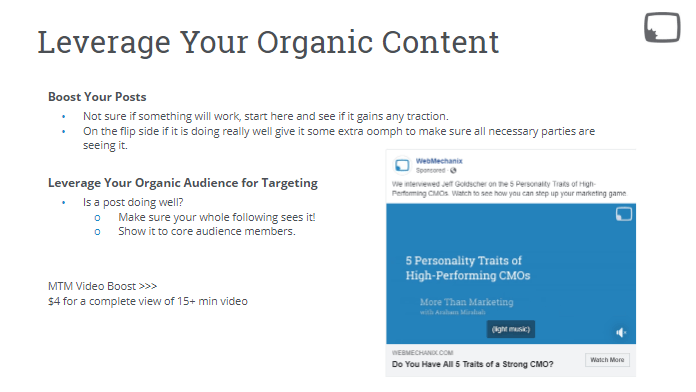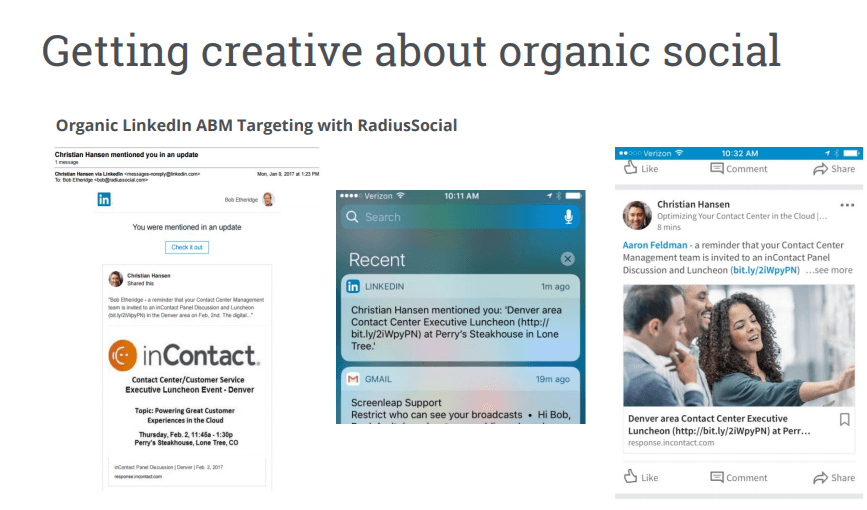
How to grow your SaaS business with social media marketing
So how do you do develop a great SaaS social media marketing strategy?
It’s important to realize that the content you’re creating on social media channels can tie in well with pay-per-click campaigns. The true potential of this kind of approach means that you can be driving organic traffic from paid and vice versa. Let’s take a closer look.
Step 1: Design your content
What exactly do we mean by designing your content? Winning in social media means being able to play the content game, and playing it well.
Social media is going to be your distribution engine, and your content is going to determine how far and how quickly you get reach. And to get the most out of that content, you’ll need to audit it.
The Content Audit
When auditing your and competitors’ content, you’re going to be looking for opportunities where you notice a “content gap” or “content drought.” What has performed poorly? What has performed well?
You can do this by looking at your identifying any unfulfilled content needs. For example:
- Solving a problem that the user has (or doesn’t yet know that they have).
- Discussing a common challenge in the industry and how you’d tackle it.
- Providing a unique perspective on an otherwise trite topic in your niche.
Whatever approach you choose, it has to be something unique that’s going to underpin your advertising strategy.
Those are the kinds of opportunities you want to look for.
Grabbing the easy wins first
You also don’t have to reinvent the wheel in terms of your content. You’ll often find that there’s an existing piece that’s has performed very well that can be its own engaging topic if you could just trim the sales angle and make it social media ready. There are many existing opportunities that you can take advantage of right out of the gate. Find out what’s performing well organically. That performance is a clue that you should definitely start promoting it in some way, be that brand awareness, lead generation, and so on.
Currently, a lot of the content being promoted on social media is designed around that top-of-funnel lead generation angle, so coming in with a mid-funnel or even bottom-funnel approach is going to allow you to stand out, and that is typically the content that’s doing well.
Step 2: Don’t always do what your competitors are doing
That sounds contrary to all of the advice out there when we’re after SaaS growth marketing, but that’s right.
And it’s not because what they’re doing isn’t working. Rather, what they’re doing could be working very well—for them.
Especially on social media, people are consuming content like crazy. That’s why the last thing you want to do is to look like your competitors. You want to break out from them and create content that stands on its own merits. If they try to copy you, they’ll just look like an also-ran, and that becomes their issue, not yours.
The two types of content that ALWAYS work (regardless of industry!)
1. Decision-making content
Often, you want to take your customers from merely being interested in your products to actually considering a purchase decision. To do that, you need to publish decision-making content that not only piques their interest but also provides genuinely useful advice.
This is essentially content at the bottom of the marketing funnel, where you’re trying to convince a client to purchase your product. Decision-making content is geared toward answering specific questions related to buying to help solve a problem the consumer may have, which leads them to make a decision.
For example, if a customer is looking to have a new roof installed on their home, they might be interested in a content piece from a local roofer titled “How to Choose the Right Roofing Company.”
Decision-making content does two things: it cements the interest of the user in getting the information they need in order to make a more confident decision, and it weeds out those users who aren’t actually at that stage of the funnel so you don’t waste time with unqualified prospects.
So what works well? Consider publishing checklists or fill-in-the blank pages where the user can give their answers or compare estimates and prices. Your goal is to gently nudge the customer off the fence and get them to say, “Yes, I definitely want this.”
2. Purely informative content
The next type of content is typically oriented around research and learning more about a specific problem and the solutions available. People in the informational stage are “just browsing.” They are interested in what you have to say but not necessarily what you have to sell.
This is where thought leadership comes into play. This type of content works best to engage prospects over time so that when they are ready to buy, your service will naturally be at the top of their minds.
Of course, you shouldn’t just ignore those people who are interested but aren’t quite ready to buy.
Going back to our roofing example, if I am looking to replace my roof at some point in the future but I’m not actually ready to do it yet, I wouldn’t be interested in that aforementioned report on how to choose the right roofing company. But I may very well be interested in, for example, a Pinterest board of exterior home renovation ideas. These types of pins can be shared by email to help build up good, solid, informational content that delivers value but doesn’t push for a sale just yet.
How do you make educational content stand out? Make it entertaining as well.
Don’t forget to test!
Whenever you’re working with social media advertising, you absolutely need to test your ideas. What works for one business doesn’t necessarily work for another. The topic, how often you publish, how you promote it, and even what channels you promote it through are all going to change depending on your business.
With all of this being said, how do you go about creating great content?
The layered content strategy
A layered content strategy allows you to create content efficiently while still meeting your audience’s needs. This strategy begins with a single piece of medium- or long-form content (3,000-5,000 words), such as a webinar, an e-book, or something downloadable.
From this, you can make supporting blog posts and guest posts that can be submitted to other publications. You can even break it up into smaller guides if you want to—it really depends on how in-depth the content is. Generally speaking, you want to go as deep as possible on your first dive and then pull back to create more digestible supporting content.
Naturally, you may be stuck because you don’t know whether a specific topic will work. You don’t want to invest too much time creating an involved piece of content if it’s not going to perform well. In that case, you can reverse the strategy: Begin with short, informative pieces to see if there’s demand for a longer, more in-depth piece.
For example, if you have an idea for a topic that you know a lot of people are struggling with, you can help them solve that problem or learn more about it. Begin with the smaller pieces first, like blog posts, and measure how well they perform. If you find that there’s demand, you can begin creating larger content assets accordingly.
The social litmus test
The great thing about using organic content in social media is that it can do a great job of really informing your paid social media strategy for SaaS moving forward. Blog posts and webinars can be designed as specific tests and experiments for your general PPC campaigns, like a social litmus test.
In short, you’re using this content to test what’s happening, not just in social media but also in other advertising channels. You’re creating a multi-stage story that helps you understand the client’s place in the buying cycle. With your multi-stage story, you’re telling the user that you understand the questions they have and that you’re here to answer them. Then, you create content accordingly along every step of the customer journey to satisfy the demand.
People are going to fall in and fall out of different stages of the funnel for all kinds of reasons, some of which you can control and some that you can’t. Within your marketing automation system, you can trigger the things that bring prospects back in based on what they’re clicking on.
Revisiting our roofing example, let’s say that I’ve subscribed to your home improvement blog for updates. As I receive your latest content, I find myself clicking on things that are only relevant to replacement windows. Being the keen marketer that you are, you notice that I’m interested in this specific area of your product offering—that I clicked on five different blog posts about windows in the last week. So, accordingly, you place me in a different email campaign that’s solely focused on windows.
Going a step further, instead of just subscribing me to a relevant email list, you can also tie that into an overall advertising strategy and add me to a remarketing campaign for windows. You can show that remarketing campaign on Facebook or other advertising channels.
Publishing “holy smokes!” content
Let’s face it: Content can be boring. We’ve all created pieces that have put people to sleep because we just didn’t have something interesting to say. Content needs to be produced, and sometimes that botches your quality—it happens. But can you avoid it?
You absolutely can, and the solution is what I like to call “holy smokes content.” Start with this template:
“Holy smokes, this content is _______!”
Your job is to fill in the blank from a reader’s (positive) perspective before you create your content.
This task is easy to do, but it has a huge impact on how well your content is received by your audience.
It forces you to design the emotional experience you want the user to have, and it also feeds into emotional intelligence. So you could have, “Holy smokes, this content is [helpful],” and from there, you could start designing the content in such a way that’s mind-blowing.
That’s a very different approach to writing content that’s inspiring or entertaining, but it gives you an end goal to help you not only craft good content every time but to also do so in a way that evokes whatever kind of feeling you want your reader to experience.
This tactic also has the benefit of making your audience part of the conversation, rather than simply trying to elicit a reaction from them. They’re emotionally invested in your content in some way, and that’s a much deeper and more meaningful interaction that you’re having with them.
Choosing the correct, first platform
One of the biggest challenges you’re going to face is choosing the right platform. When you’ve got hundreds of pieces of content and you’re trying to decide where to put them, it pays to know which social networks are best for your type of content. It’s also important for SaaS influencer marketing since each platform may or may not have the influencers who could magnify your reach:
- Facebook—best for testing. Lots of people are on Facebook, so it’s a good choice if you just want to know what works for your audience or when you should be doing something. Facebook is making a push toward segmenting people into groups and encouraging the creation of groups accordingly, so that will definitely help you with your marketing efforts.
The one area of social media that Facebook fails spectacularly at is video. For example, if you’re watching a longer video and you get called away, you can’t exactly bookmark your video and come back and pick up after that spot.
Obviously, YouTube is one of Facebook’s major competitors, so they definitely don’t want people leaving Facebook to go there. As a result, they prefer native videos uploaded directly to Facebook. But since you can’t simply bookmark the video and come back later, it’s a good idea to put the YouTube link in the description of the video while it’s uploading on Facebook.
- LinkedIn—best for career-related news and content, such as professional networking advice.
- Instagram—photos and hashtags, as well as certain social trends. For example, think of the #10YearChallenge. It’s important to note that not every hashtag that’s trending has to be pigeon-holed into your brand in some way. There will be another hashtag along shortly that may even be a better match. Just be patient.
- Reddit—Reddit organizes things by subreddit, and there are subreddits for every conceivable topic you can imagine, with the most popular posts floating to the top of the feed. You can see how many people have joined a particular subreddit. Reddit tends to attract younger male audiences, but that may not be the case for the specific subreddit you target. For example, there’s an entire subreddit dedicated to retirement.
- Quora—If people are asking questions about your specific topic, you can answer them here. Quora is also a great place if you have a particularly complex offer, and you need a platform to really extoll its virtues and explain it in more detail.
- Twitter—ideal for impressions, as well as seeing what hashtags are trending. Why not just use Facebook for hashtags? The reason is because hashtags haven’t really caught on there the way that they have on places like Twitter and Instagram. Oddly enough, hashtags don’t really cross-pollinate to other platforms.
- Pinterest—a huge female focus centered around photos, particularly of food, weddings, decor, and shopping.
Appeasing the social media algorithm
One of the biggest myths in social media content marketing is that you have to throw money behind an initiative if you want to get a decent amount of reach. While it’s true that you should put some paid advertising behind your promotion, you can absolutely improve your overall reach just by making the algorithm like you more.
So… How exactly do you do that?
Consider this: When you’re on a platform like Facebook, think about what your friends are posting on there. They’re posting pictures of their babies or their vacations, right? What are your friends posting on Instagram? Their pets and vacations, most likely.
Your goal is to subtly tweak your content or ad so it looks similar to what people are sharing on those platforms, rather than screaming “Buy something from me!” at the top of your lungs. In other words, look for ways to show off your product as part of a native, desirable part of the organic feed without being overtly promotional.
It’s important to keep in mind that when you’re doing organic content marketing, the personal reason that you’re using something is much more relevant than the money that you throw at it. Contrary to popular belief, you don’t have to always be selling.
For example, if every interaction you have with a company has them telling you to buy something, rather than helping you connect with the people and the faces behind the company, it doesn’t really foster that kind of interaction that people crave from businesses. Customers understandably don’t want to be perceived as nameless, faceless, open wallets.
Increasing the reach and exposure of your message
The other piece of the puzzle is that you want more engagement from people, but you also want to reach more people with your message and encourage them to hear what you have to say.
But how do you do that?
It’s important to note that every platform has some kind of robot or algorithm that customizes a user’s experience based on the kind of content they enjoy. On Reddit, for example, a user’s home page shows a collection of trending posts from the subreddits they’ve subscribed to.
In short, if people like what you’re doing, you’ll get shown more often because these networks want people to stay on them longer. Of course, many algorithms are more sophisticated than that. For example, Facebook tends to raise posts that evoke some kind of emotional reaction, be that happiness, sadness, anger, awe, or agreement. Of course, you want to tread carefully with things that will provoke people, but ask yourself what gets the most engagement.
In addition, these algorithms look at post frequency. They want people not only hanging around but also doing so frequently. So the more often you engage with people—by following accounts or companies, liking posts, replying to all comments, and so on—the higher up your post will appear on those personalized feeds.
In the case of Facebook, the network only shows the first three comments or so for a post. So as long as you’re interacting with at least those, other people will see those comments, and the more influential or engaging ones will rise to the top. This also saves you a ton of time because you don’t have to interact with all 500 comments if you don’t have the time to do so.
Just ask for it!
Nobody likes a false pretense, especially when it comes to marketing. We mentioned earlier that you should try to blend in with the crowd instead of jumping to promote your product—and that’s sound advice. But at the same time, you shouldn’t just stand by and hope people will begin following you and buying from you naturally with time—there comes a point when you simply have to ask for it.
For example, Facebook has a feature that makes it easy for you to see who’s engaging with your posts, and if they’re already a follower or not. You can also send out cross invites, encouraging people to follow you on Instagram, Twitter, and many other social platforms.
Another great thing that you can ask for is user-generated content. Encourage people to use your hashtag or participate in a photo contest, and they’ll get on board more quickly than if you were to simply look for recognition. Then, you’ve got tons of free content that they agreed to give you and that you can use and share however you see fit!
Let’s say you’re at a local restaurant and take a photo of what you ordered and tag the restaurant. They may very well take your photo and share it with their own audience, making you a local celebrity for a hot minute. It not only makes you feel good and more likely to come back to that restaurant, but it also shows that this company is involved with and interacting with their community in a positive way. And that can easily attract the right kind of business.
SaaS marketing best practices for paid advertising
The best way to put your paid advertising to use is to look at what’s doing well for you organically. If you tailor a piece of content for CEOs and key decision-makers, for example, you want to promote it so that only that segment sees it. Of course, other people may still come across the same content organically, but you’re not paying for those clicks—you’re reaching exactly who you want to reach, without paying a lot to get a bunch of views that may not convert. And it works regardless of whether these people are in your network.
As an example, we ran a video ad that was 15 minutes long. You wouldn’t think that anyone would sit there and watch a 15-minute video on social media, but we had over 200 people watch the whole thing, and it only cost us $4.

Paid advertising is also a relatively inexpensive way to see if a test idea is going to pick up steam. Not sure if something is going to be worth it? Boost it—put $5 behind it, and see what happens.
You can also boost a post to potential audiences just to see how they react. Of course, you want to be sure that your core audience reacts to your content, so promote it to that specific audience in any case.
Podcast shows are another option. iTunes is the most popular podcast directory, but a lot of people are also consuming video with their podcasts, so it’s a smart idea to run your video alongside that podcast.
Account-based marketing on LinkedIn with RadiusSocial
One method we’ve found on social media, particularly with regard to LinkedIn, is using RadiusSocial for our account-based marketing. This works really well within the B2B space, especially when you’re trying to target key decision-makers and get actionable results.
Radius Social targets your prospect list and automatically creates individual posts tagging each of them. For example, if you have a potential B2B client that’s going to be at a trade show, you can publicly tag them and encourage them to take some action, like downloading a whitepaper or webinar or whatever.

So rather than having a salesperson on the floor standing at a booth waiting for people to come to them, you can use a platform like Radius Social to easily fill up your calendar with targeted meetings from the kinds of people you want to reach. And you can absolutely use this in combination with other strategies, like a LinkedIn InMail strategy.

The best part is that LinkedIn isn’t really your typical social network, so even though you’re tagging each person individually, nobody’s going to go on your profile and look and see that you’re doing that, and their news feed won’t reveal your behavior since it usually only shows one, engaging post from each authority.
Taking your social content to the next level
So now that you know how best to leverage your content for social media, the next step is to get out there and put these tips to use in your SaaS social media marketing. For those of you who have successfully used social media to market your content, which network and type of content have performed best for you?
Most newsletters suck...
So while we technically have to call this a daily newsletter so people know what it is, it's anything but.
You won't find any 'industry standards' or 'guru best practices' here - only the real stuff that actually moves the needle.






